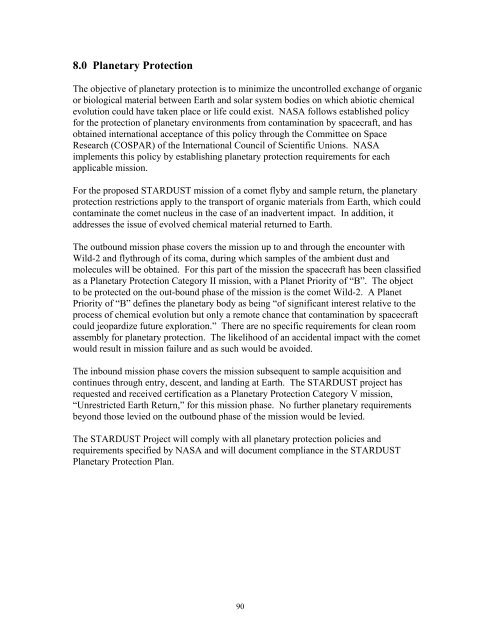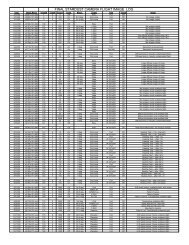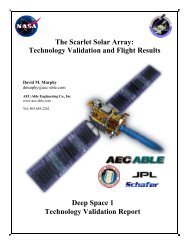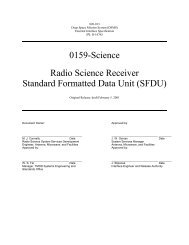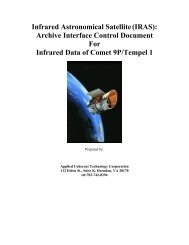MISSION PLAN - PDS Small Bodies Node
MISSION PLAN - PDS Small Bodies Node
MISSION PLAN - PDS Small Bodies Node
Create successful ePaper yourself
Turn your PDF publications into a flip-book with our unique Google optimized e-Paper software.
8.0 Planetary Protection<br />
The objective of planetary protection is to minimize the uncontrolled exchange of organic<br />
or biological material between Earth and solar system bodies on which abiotic chemical<br />
evolution could have taken place or life could exist. NASA follows established policy<br />
for the protection of planetary environments from contamination by spacecraft, and has<br />
obtained international acceptance of this policy through the Committee on Space<br />
Research (COSPAR) of the International Council of Scientific Unions. NASA<br />
implements this policy by establishing planetary protection requirements for each<br />
applicable mission.<br />
For the proposed STARDUST mission of a comet flyby and sample return, the planetary<br />
protection restrictions apply to the transport of organic materials from Earth, which could<br />
contaminate the comet nucleus in the case of an inadvertent impact. In addition, it<br />
addresses the issue of evolved chemical material returned to Earth.<br />
The outbound mission phase covers the mission up to and through the encounter with<br />
Wild-2 and flythrough of its coma, during which samples of the ambient dust and<br />
molecules will be obtained. For this part of the mission the spacecraft has been classified<br />
as a Planetary Protection Category II mission, with a Planet Priority of “B”. The object<br />
to be protected on the out-bound phase of the mission is the comet Wild-2. A Planet<br />
Priority of “B” defines the planetary body as being “of significant interest relative to the<br />
process of chemical evolution but only a remote chance that contamination by spacecraft<br />
could jeopardize future exploration.” There are no specific requirements for clean room<br />
assembly for planetary protection. The likelihood of an accidental impact with the comet<br />
would result in mission failure and as such would be avoided.<br />
The inbound mission phase covers the mission subsequent to sample acquisition and<br />
continues through entry, descent, and landing at Earth. The STARDUST project has<br />
requested and received certification as a Planetary Protection Category V mission,<br />
“Unrestricted Earth Return,” for this mission phase. No further planetary requirements<br />
beyond those levied on the outbound phase of the mission would be levied.<br />
The STARDUST Project will comply with all planetary protection policies and<br />
requirements specified by NASA and will document compliance in the STARDUST<br />
Planetary Protection Plan.<br />
90


